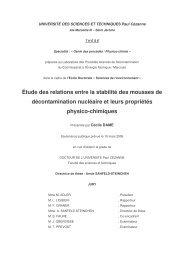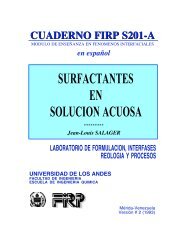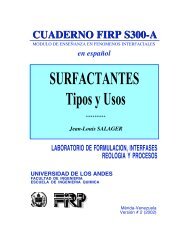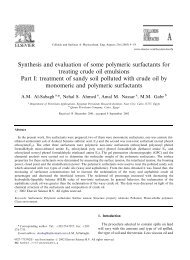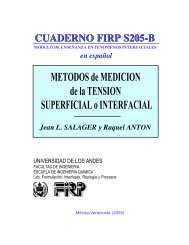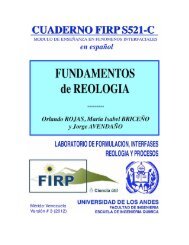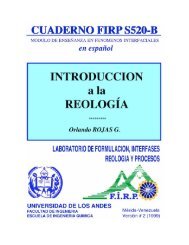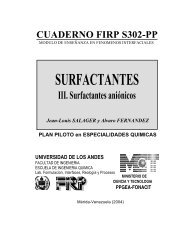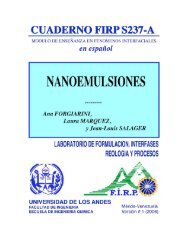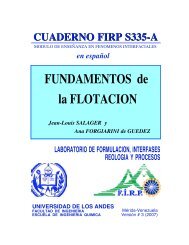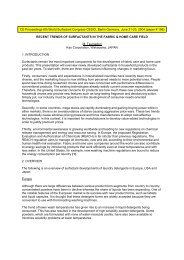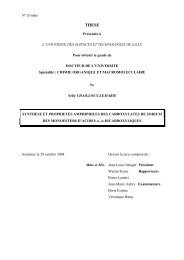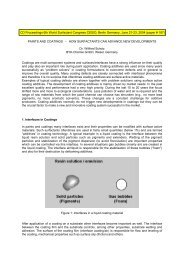Solubilization-emulsification mechanisms of detergency
Solubilization-emulsification mechanisms of detergency
Solubilization-emulsification mechanisms of detergency
You also want an ePaper? Increase the reach of your titles
YUMPU automatically turns print PDFs into web optimized ePapers that Google loves.
C.A. Miller and K.H. Raney/Colloids Surfaces A: Physicochem. Eng. Aspects 74 (1993) 169-215 213<br />
In the preceding section, it was mentioned<br />
that the time required for removal <strong>of</strong> mixed<br />
hydrocarbon-long-chain alcohol soils increases<br />
when the initial state <strong>of</strong> the system is further<br />
above the PIT. This result is consistent with the<br />
intuitive expectation that surfactant would have<br />
to diffuse into the oil for a longer time before<br />
liquid crystal formation occurred for systems<br />
further above the PIT as well as with the<br />
quantitative values <strong>of</strong> the parameter K s in Eq.<br />
(6) found for soils with different compositions.<br />
It is also noteworthy that in some <strong>of</strong> the<br />
contacting experiments, convection arose<br />
spontaneously near the interface, an effect that<br />
would also speed up mass transfer. The<br />
Marangoni flow mentioned in connection with<br />
Fig. 19 for the C12E5-water-n-tetradecane<br />
system at 20ºC is one example, although it<br />
occurred for a situation when soil removal is<br />
minimal owing to a low solubilization capacity<br />
<strong>of</strong> the surfactant solution. Perhaps more relevant<br />
to <strong>detergency</strong>, vigorous convection was<br />
sometimes seen during the early stages <strong>of</strong><br />
formation <strong>of</strong> a non-wetting intermediate phase,<br />
i.e. one that forms preferentially as lenses rather<br />
than as a continuous layer. Intermediate phase<br />
formation in the C 12E 5-water-n-tetradecane<br />
system at temperatures just below and above the<br />
cloud point is an example. If non-uniformities in<br />
intermediate phase thickness develop<br />
immediately following the initial contact when<br />
the phase is a still a thin liquid film, disjoining<br />
pressure effects will promote flow from thin to<br />
thick portions <strong>of</strong> the film, thus increasing the<br />
discrepancies in thickness. Diffusion processes<br />
will continue to form more <strong>of</strong> the intermediate<br />
phase in the thin regions, and disjoining<br />
pressure gradients will continue to drive the<br />
newly formed material to thicker regions.<br />
No soil removal experiments are currently<br />
available for the systems discussed above<br />
containing mixed triolein-oleyl alcohol soils and<br />
a pure nonionic surfactant. The contacting<br />
experiments indicate, however, that the first<br />
intermediate phase formed is D', which<br />
solubilizes little triolein although readily<br />
incorporating alcohol. It may be that some <strong>of</strong> the<br />
same ideas suggested above to improve<br />
<strong>detergency</strong> with pure triolein, e.g. use <strong>of</strong><br />
secondary alcohol ethoxylate surfactants, will be<br />
needed to achieve high degrees <strong>of</strong> removal <strong>of</strong><br />
the triolein portion <strong>of</strong> these mixed soils. Of<br />
course, liquid triglyceride soils normally contain<br />
some fatty acids formed by triglyceride<br />
hydrolysis. In addition, lipase enzymes are<br />
incorporated into some detergent formulations<br />
to promote the breakdown <strong>of</strong> triglycerides into<br />
monoglycerides, diglycerides and fatty acids.<br />
Increasing the pH can convert these acids to<br />
soaps, which could well improve <strong>detergency</strong>.<br />
This behavior is currently being studied by the<br />
contacting techniques discussed above.<br />
12. Conclusions<br />
<strong>Solubilization</strong>-<strong>emulsification</strong> is a key<br />
mechanism in the removal <strong>of</strong> oily liquid soils<br />
from polyester and polyester-cotton fabrics.<br />
Systematic studies, discussed above, utilizing<br />
several model soils indicate that solubilization<br />
into an intermediate phase formed during<br />
washing is generally much more extensive and<br />
rapid than solubilization into a micellar solution.<br />
Accordingly, knowledge <strong>of</strong> the phase behavior<br />
<strong>of</strong> surfactant-soil-water systems is needed to<br />
make a rational choice <strong>of</strong> optimum surfactant<br />
compositions and washing conditions. With<br />
hydrocarbon soils, for instance, washing at<br />
temperatures near the PIT is best. The<br />
intermediate phase is a microemulsion although<br />
the lamellar liquid crystalline phase may form as<br />
well if it is not already present in the initial<br />
washing bath. For commercial non-ionic<br />
surfactants and their mixtures with anionic<br />
surfactants, the appropriate PIT in the usual case<br />
<strong>of</strong> washing with a high surfactantto-oil ratio is<br />
that for which the composition <strong>of</strong> the surfactant<br />
films in the middle-phase microemulsion is that<br />
<strong>of</strong> the surfactant mixture in the initial washing<br />
bath.<br />
For mixed soils containing hydrocarbons and<br />
long-chain alcohols or fatty acids, good soil<br />
removal is achieved at temperatures above the<br />
PIT but below the cloud point <strong>of</strong> the surfactant.<br />
In this case the PIT is evaluated at high<br />
surfactant-to-oil ratios as above with the<br />
additional condition that the excess oil phase in<br />
equilibrium with the microemulsion has the



